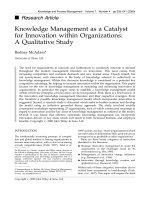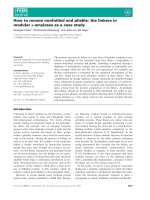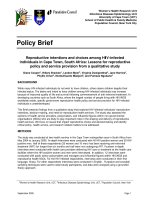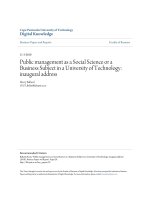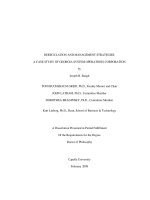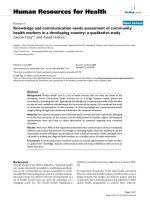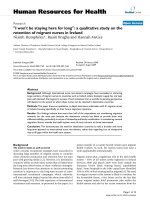Knowledge Management as a Catalyst for Innovation within Organizations: A Qualitative Study
Bạn đang xem bản rút gọn của tài liệu. Xem và tải ngay bản đầy đủ của tài liệu tại đây (117.35 KB, 9 trang )
&
Research Article
Knowledge Management as a Catalyst
for Innovation within Organizations:
A Qualitative Study
Rodney McAdam*
University of Ulster, UK
The need for organizations to innovate and furthermore to ceaselessly innovate is stressed
throughout the modern management literature on innovation. This need comes from
increasing competition and customer demands and new market areas. Closely linked, but
not synonymous, with innovation is the body of knowledge referred to collectively as
knowledge management. Within this discourse knowledge is considered as a potential key
competitive advantage, by helping to increase innovation within the organization. This paper
focuses on the role of knowledge management in sustaining and enhancing innovation in
organizations. In particular the paper seeks to establish a knowledge management model
within which the principles of innovation can be incorporated. First, there is a brief review of
the innovation and knowledge management literature and their respective synergies. From
this literature a possible knowledge management model which incorporates innovation is
suggested. Second, a research study is discussed which seeks to further examine and develop
the model using an inductive grounded theory approach. The study involved socially
constructed workshops representing 25 organizations, each of which constructed meanings in
regard to innovation and the key areas of knowledge management as outlined in the model.
Overall it was found that effective systematic knowledge management can incorporate
innovation drivers in key areas which will result in both increased business and employee
bene®ts. Copyright # 2000 John Wiley & Sons, Ltd.
INTRODUCTION
The continuously increasing pressure of competi-
tion and global markets is forcing organizations to
become more innovative, with a view to increasing
overall competitiveness (Tidd, 1997). Tidd et al.
(1997) points out that: `those [organizations] which
use innovation to differentiate their products are on
average twice as pro®table as other organizations'
There are three broad categories of innovation
identi®ed in the literature:
$
Strategic innovative management to assist the
organization in the challenges faced by its
environment (e.g. Pitt, 1998)
$
Management of innovative change initiatives
(e.g. Davenport et al., 1996)
$
Innovation through knowledge creation and
application (e.g. Demerest, 1997).
Within each of these categories, innovation can be
ranked from incremental to breakthrough (Tush-
man et al., 1997). This paper will inquire the third
Dr McAdam is a Senior Lecturer and MBA course director at
the School of Management, University of Ulster. He has a large
number of publications in the area of business improvement,
process management and knowledge management and is a
regular conference speaker. He has extensive consulting
experience and worked in the aerospace industry before joining
the university.
*Correspondence to: Rodney McAdam, School of Management,
University of Ulster, Newtownabbey, Belfast BT370, UK.
E-mail:
Knowledge and Process Management Volume 7 Number 4 pp 233±241 (2000)
Copyright # 2000 John Wiley & Sons, Ltd.
category of innovation: how innovation relates to
knowledge. The ®rst two categories are vitally
important. However, large bodies of knowledge
already exist in these areas, while the third area is
relatively emergent as a discourse.
KNOWLEDGE MANAGEMENT AND
INNOVATION
Concurrently with the developments in the ®eld of
innovation, there is the hegemony of knowledge
management as a key element in improving
organizational competitiveness (Hedlund, 1994).
Knowledge management includes new knowledge
construction, knowledge embodiment, knowledge
dissemination and knowledge use/bene®t (Demer-
est, 1997). Quintas et al. (1997) state `Knowledge
management is the process of critically managing
knowledge to meet existing needs, to... exploit
existing knowledge...and to develop new opportu-
nities'. These de®nitions indicate that knowledge
management has the potential to be a catalyst for
innovation within organizations.
The aim of this paper is to investigate the
possible use of knowledge management within
organizations as a catalyst or vehicle for increasing
innovation, and hence competitiveness. Existing
models of KM fall into three broad categories:
intellectual capital models (Edvinnson, 1997),
knowledge category models (Nonaka and Takeu-
chi, 1995) and social constructionist models
(Demerest, 1997). The model chosen for the current
study is a modi®ed version of Demerest's model
as it is more holistic than the mechanistic intellec-
tual capital models and the reductionist know-
ledge category models. The model (Figure 1)
essentially consists of a highly recursive ¯ow
involving four key areas of knowledge.
First, there is the area of knowledge construction
where the construction is not limited to that of
scienti®c inputs but includes the social construc-
tion of knowledge. Second, the constructed know-
ledge is embodied within the organization through
a process of social interchange. Third, the em-
bodied knowledge is disseminated throughout
the organization. Fourth, the use/bene®ts of KM
considers both business and employee emancipa-
tory bene®ts. In effect, as seen in Figure1, there is
no speci®c routing of knowledge around these
four key areas, but rather a highly recursive
dynamic is produced. The contribution of this
view of KM towards the development of innova-
tion is considered as follows, based on the four key
areas of the model shown in Figure 1.
Knowledge construction and innovation
Knowledge construction includes the creation and
recognition of knowledge that is socially con-
structed as well as that which is scienti®c in
character. Organizations which take this approach
are innovative as they allow new types of
knowledge to become recognized and applied
throughout the organization. Nonaka and Takeu-
chi (1995) and Boisot (1989) see this innovative
recognition and use of knowledge coming from
social interaction, where employees are seen as
actively constructing knowledge. Amidon (1998)
considers this type of knowledge to be the key
input for the process of innovation within organi-
zations. This taxonomy of knowledge allows
practical and experiential learning processes to be
acknowledged as sources or constructs of innova-
tive knowledge (Marshall and Reason, 1993).
Hence interaction between employees can be seen
as knowledge creation. Furthermore, within these
learning processes critical re¯ection and re¯exivity
within employees must be encouraged so that
`taken for granteds' are questioned and hence the
maximum potential of new knowledge is con-
structed (Alvesson and Willmott, 1996; Demerest,
1997). McCartney (1998) views this process as
`making nuggets [of knowledge] from where the
organization has done things'.
By accepting socially constructed knowledge
organizations are not restricted to knowledge
being generated by management but can obtain
knowledge from all levels in the organization and
from outside the organization (e.g. customers,
suppliers). Nonaka and Takeuchi (1995) describe
this innovation as `boundary spanning knowledge
construction'. Thus, knowledge construction
(Figure 1) is seen as the gateway to innovation
within the organisation. Unless knowledge is
constructed on both a social and a scienti®c basis
the process of innovation will not become embo-
died and disseminated within organizations. This
failure will ultimately result in a lack of embodied
knowledge within new products (Madhaven,
1998).
Knowledge embodiment and innovation
If organizations can ensure the process of innova-
tion commences with new knowledge construction
then such knowledge must be embodied (Figure 1)
within the organization. The embodiment of new
knowledge will enable innovation to become an
essential part of the organization (Hedlund and
Nonaka, 1993). McCartney (1998) states that `the
activities that give rise to innovation are basically
RESEARCH ARTICLE Knowledge and Process Management
234 R. McAdam
the management of knowledge ¯ows'. Polanyi
(1962) sees embodiment essential, as in most
organizations the rule: `we know more than we
can tell' applies.
Attempts to embody the new knowledge should
lead to innovative organizational structures
(Nonaka and Takeuchi, 1995; Handy, 1989). Orga-
nizations no longer need to guard `scienti®c'
knowledge in the apex of pyramidal structures
but instead can form learning networks which
span geographic location and organizational
boundaries. Drath and Paulus (1994) describe
such structures as `proactive learning networks'.
Instead of a `them and us' approach, a `collegiate'
pattern develops (Peters, 1992). Boot et al. (1994)
view this approach as leading to `more agility
and responsiveness to innovation'. This agility
will become increasingly important as markets
become increasingly fragmented (i.e. niche rather
than segment driven) and organizations are forced
to have `ceaseless innovation' (Demerest, 1997).
Innovation is not a `one act drama...but an ongoing
process' (Nonaka and Takeuchi, 1995).
Innovative organizational structure alone is not
suf®cient for the embodiment of new knowledge.
There must be concurrent innovative develop-
ments within the role of the organization's
people. Peters (1992) states that employees should
be considered as `brokers of knowledge' rather
than simply as task orientated. Zuboff (1988)
describes such employees as `knowledge workers'.
If these knowledge workers are to thrive and
progress the process of innovation by embodying
new knowledge within the organization, then the
culture of the organization must be addressed. 3M
consider the tacit knowledge culture to be essential
for innovation (Brand, 1998). Handy (1989) states
that the organization must become `open' and
receptive to knowledge workers ideas rather than
closed. Pitt (1998) states the need for openness
and freedom to encourage group interaction and
sharing. Millar (1998) describes this as `open-
mindedness' in which a blame-free experimental
approach can be accepted and adopted. In this
innovative environment mistakes must be toler-
ated (Brand, 1998). The culture is one of `openness,
learning and collaboration'.
Knowledge workers also increase innovation by
turning tacit knowledge into explicit knowledge
and by passing tacit knowledge onto others
(Nonaka and Takeuchi, 1995; Hedlund, 1994).
Wetlaufer (1999) sees this process as involving
endless small-group discussions between employ-
ees in an open and conducive environment. Brand
(1998) considers that this `willingness to share'
must `permeate the entire ®bre of the organistion'.
The chief executive of Ford (Wetlaufer, 1999)
describes the process as `telling stories' about
experiences. Madhaven (1998) states that teams
involves in embodying this new knowledge must
develop and use new mental models which
support innovation. To encourage this process
of knowledge embodiment some organizations
encourage job rotation and send employees to
Figure 1 Knowledge management model (modi®ed version of Demerest's model)
Knowledge and Process Management RESEARCH ARTICLE
Knowledge Management as a Catalyst for Innovation 235
work in different parts of the organization. Also,
some organizations (e.g. 3M and Caterpillar) set
aside speci®ed time periods each week where
employees can develop their own innovative
ideas in small teams).
In summary, knowledge embodiment can build
on new knowledge construction and enable the
process of innovation to be further incorporated
within the organization.
Knowledge dissemination and innovation
Innovation includes not only the construction and
embodiment of new knowledge, but also the
dissemination (Figure 1) of proven new knowledge
across the organization and its environs (including
customers and suppliers) (Demerest, 1997). Only
through this dissemination process can Polanyi's
(1962) observation (see above) be addressed. Peters
(1992) emphasizes the role of organizational struc-
ture in disseminating new knowledge which leads
to innovation. He sees learning networks or
`spider's web' type structures as being able to
rapidly spread new knowledge which will lead
to increased knowledge embodiment in the form
of new products and services throughout the
organization.
Knowledge dissemination should not be adhoc
but, as pointed by Pitt (1998), `exemplar organiza-
tions are systematic at making intuitive experien-
tial knowledge explicit and in diffusing it more
widely in the enterprise'. Gurteen (1998) sees this
happening through dynamic interaction among
learning networks (Robertson et al., 1996) which
are free from the encumbrances of functional
hierarchies. Roberts et al. (1998) point out that it
should not be assumed that knowledge ¯ows from
the corporate centre but may now be based in the
`peripheries of the organization. Thus, innovation
is no longer the domain of senior management but
can arise anywhere and at any level in the
organization. Nonaka and Takeuchi (1995) see
this new knowledge dissemination as leading to
`innovation that is systematic and continuous'.
Knowledge workers have a key role in achieving
increased innovation through knowledge dissemi-
nation. Acting in cross-geographical boundaries
these knowledge workers can `sift and re®ne and
implement' (Gurteen, 1998) ideas from across the
organization. Sometimes this process is achieved
by moving members from successful past teams
into new teams in other areas, by job rotation and
by using experienced mentors for teams (Mad-
haven, 1998). As interaction with customers and
suppliers increase, the knowledge worker will
disseminate and embody new knowledge far
beyond the organizational boundaries, leading to
increased innovative partnerships and alliances
(Nonaka and Takeuchi, 1995).
If organizations are to systematically dissemi-
nate new knowledge to achieve increased innova-
tion, as suggested by Pitt (1998), the key processes
will need to be identi®ed throughout the organiza-
tion, its customers and suppliers (Davenport et al.,
1996). These common processes will act as rapid
carrier vehicles for the increased dissemination of
new knowledge. For example, Nonaka and Takeu-
chi (1995) single out the new product development
process as entraining and disseminating new
knowledge in all areas of the organization.
McCartney (1998) states that these process are
essential for the `management of knowledge ¯ow'
or dissemination throughout the organization.
Thus, if organizations are to effectively deploy
innovation they must ensure that new knowledge,
which has been effectively embodied, must also be
disseminated throughout the organization if a
process of `ceaseless innovation' (Nonaka and
Takeuchi, 1995) is to become effective.
Knowledge use/bene®t and innovation
Organizations which are noted for being innova-
tive usually have an effective knowledge manage-
ment system (i.e. construction, embodiment and
dissemination of knowledge). For example, 3M's
key mission is to become the most innovative
company in the world and it sees effective
knowledge management as the way to achieve
this goal. 3M requires each one of its businesses to
have at least 30% of its sales from products not in
the line four years ago (Brand, 1998). The organi-
sation is a good example of organisation's which,
in the words of Nonaka and Takeuchi (1995),
`ceaselessly innovate'. These characteristics are
increasingly important in organizations as tradi-
tional predictable markets become ever more
fragmented and volatile. To `thrive on chaos'
(Peters, 1992), organizations must ceaselessly inno-
vate or decline.
Also, with innovation resulting from effective
knowledge management there is an opportunity
to `square the circle' of business bene®t and
employee emancipation. The business bene®ts of
increased growth through innovative new pro-
ducts and services can be paralleled with con-
current increases in employee creativity and
empowerment (e.g. Caterpillar allow employees
to spend 10% of their time developing their own
ideas in small teams).
RESEARCH ARTICLE Knowledge and Process Management
236 R. McAdam
RESEARCH METHODOLOGY FOR THE
CURRENT STUDY
To further develop and investigate knowledge
management and innovation a qualitative research
study was carried out. The research method is
illustrated in Figure 2.
Research survey
The quantitative element of the research method-
ology involved using a questionnaire to survey the
scope of KM in regard to key trends. The survey
data was not used to establish reasons and mean-
ings. The survey ®ndings are fully discussed in
McAdam and McCreedy (1999).
Participative workshops
The survey data showed who was willing to
participate in the workshops, based on the level
of their organization's involvement in knowledge
management. Thus, those participating in the
workshops were interested and involved in the
area of knowledge management and agreed to
participate further.
The main purpose of the research was to
inductively build theory using grounded theory
(Glauser and Strauss, 1967). In this case the
grounded approach was that of social construc-
tionist workshops (Easterby-Smith and Thorpe,
1997) involving managers from organizations
involved in knowledge management. In these
workshops the groups of managers negotiated
meaning in relation to a topic (knowledge manage-
ment and innovation in this case).
This approach is consistent with the overall idea
of constructing knowledge socially. The work-
shops were run by asking the participants to
discuss each of four generic areas of the KM
process shown in Figure 2. In total there were ®ve
workshops run which represented 25 different
organizations from all sectors.
WORKSHOP FINDINGS: KNOWLEDGE
CONSTRUCTION AND INNOVATION
The entire area of knowledge construction is akin
to innovation in that new knowledge is being
created which can them be incorporated within the
organization (Nonaka and Takeuchi, 1995). This
view was summed up by a participant:
`We are working in the realms of creativity
here [workshop discussion on knowledge
construction] rather than simply discussing
knowledge.'
Effective knowledge construction was seen as
opening up the gateway to innovation:
`I have these facts and ®gures but how do I
use them creatively?'
`Knowledge is...how to open up possibilities,
how to open up other options?'
Gurteen (1998) describes this as the ability to think
in `an abundance of new ways' which will open
up the road to innovation within organizations.
The participants quickly concluded that know-
ledge leading to increased innovation would have
to be much wider than the paradigm of scienti®c
knowledge construction:
`It is much wider...for example meeting here, we
could be meeting on the shop¯oor somewhere
having a chat, or an of®ce, there is an argument
that we are constructing knowledge [in these
situations].'
Thus, it was realized that knowledge construction
leading to increased innovation depended on
socially constructed knowledge as well as scienti-
®cally constructed knowledge (Alvesson and Will-
mott, 1996). This socially constructed knowledge
was considered to be tacit in addition to explicit
knowledge:
`The tacit knowledge is the in¯uential know-
ledge that will make...dynamic organizations.'
Such a view is similar to that of Boisot (1989) and
Hedlund and Nonaka (1993).
When the participants had constructed their
wider views on knowledge construction they
seemed to recognize the possibilities that were
opened up for increased innovation:
Figure 2 Research methodolgy
Knowledge and Process Management RESEARCH ARTICLE
Knowledge Management as a Catalyst for Innovation 237
